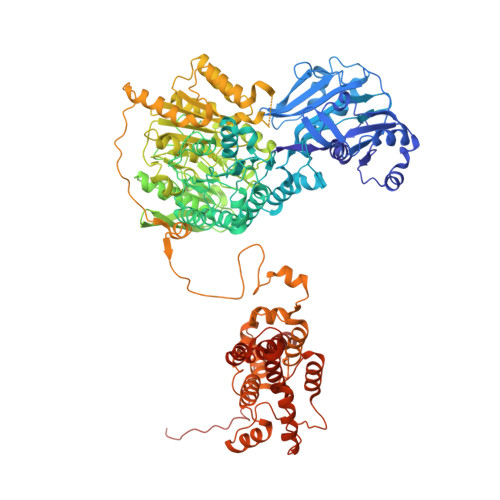An allosteric mechanism for potent inhibition of human ATP-citrate lyase.
Wei, J., Leit, S., Kuai, J., Therrien, E., Rafi, S., Harwood Jr., H.J., DeLaBarre, B., Tong, L.(2019) Nature 568: 566-570
- PubMed: 30944472
- DOI: https://doi.org/10.1038/s41586-019-1094-6
- Primary Citation of Related Structures:
6O0H - PubMed Abstract:
ATP-citrate lyase (ACLY) is a central metabolic enzyme and catalyses the ATP-dependent conversion of citrate and coenzyme A (CoA) to oxaloacetate and acetyl-CoA 1-5 . The acetyl-CoA product is crucial for the metabolism of fatty acids 6,7 , the biosynthesis of cholesterol 8 , and the acetylation and prenylation of proteins 9,10 . There has been considerable interest in ACLY as a target for anti-cancer drugs, because many cancer cells depend on its activity for proliferation 2,5,11 . ACLY is also a target against dyslipidaemia and hepatic steatosis, with a compound currently in phase 3 clinical trials 4,5 . Many inhibitors of ACLY have been reported, but most of them have weak activity 5 . Here we report the development of a series of low nanomolar, small-molecule inhibitors of human ACLY. We have also determined the structure of the full-length human ACLY homo-tetramer in complex with one of these inhibitors (NDI-091143) by cryo-electron microscopy, which reveals an unexpected mechanism of inhibition. The compound is located in an allosteric, mostly hydrophobic cavity next to the citrate-binding site, and requires extensive conformational changes in the enzyme that indirectly disrupt citrate binding. The observed binding mode is supported by and explains the structure-activity relationships of these compounds. This allosteric site greatly enhances the 'druggability' of ACLY and represents an attractive target for the development of new ACLY inhibitors.
- Department of Biological Sciences, Columbia University, New York, NY, USA.
Organizational Affiliation:


















